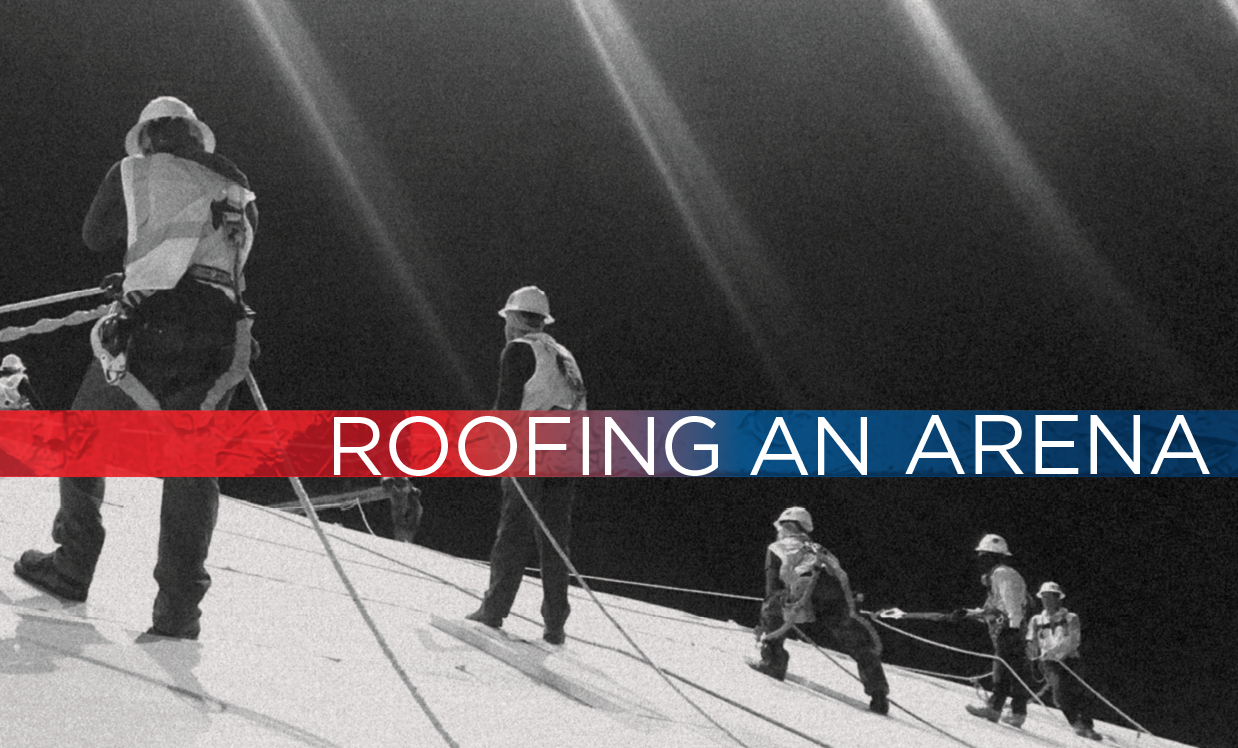As metal panel roof systems continue to rise in popularity, you need to be aware of the requirements and recommendations related to their installation. But first, it is important to understand how these systems differ.
NRCA distinguishes between two primary categories of metal panel roof systems: structural and architectural. Metal panels used in structural metal panel roof assemblies have the strength and capability of spanning structural members, such as joists or purlins, without being supported by a continuous or closely spaced roof deck. Structural metal panel roof assemblies typically are weatherproof. They are designed to resist the passage of water at joints, laps and junctures under minimal hydrostatic pressure. In most configurations, structural metal panel roof systems do not require underlayments.
Architectural metal panel roof systems require continuous or closely spaced substrates. Architectural metal panel roof systems typically are designed to shed water rapidly over the panels’ surface, so the seams are not necessarily watertight.
It’s worth noting metal shingle roof systems are considered water-shedding roof systems, as well. Metal roof shingles differ from metal roof panels in that shingles are smaller elements. The International Building Code,® 2021 Edition provides the following definitions for a metal roof panel and metal roof shingle: “Metal Roof Panel: An interlocking metal sheet having a minimum installed weather exposure of 3 square feet (0.279 m2) per sheet. Metal Roof Shingle: An interlocking metal sheet having an installed weather exposure less than 3 square feet (0.279 m2) per sheet.”
Metal shingles can take the shape of individual or multiple asphalt, tile, slate or wood shingle configurations. They also can be formed in various shapes and in single or multiple courses.
Metal panel roof systems can be further categorized into either flat or standing seam. For flat seams, the edges of two adjacent sides of each rectangular sheet are folded over a minimum of ¾ of an inch; the edges of the two other adjacent sides are folded under a minimum of ¾ of an inch. Flat-seam metal panel roof systems with nonsoldered seams are intended to shed water whereas when the joints are soldered, they become weatherproof.
The term “standing seam” refers to almost any kind of metal roof panel with a raised vertical seam. However, strictly speaking, it refers to those metal panels that interlock or are seamed together vertically above the panel’s pan. Standing seams can be used as architectural elements to highlight aesthetics, accommodate thermal movement, facilitate panel interlocking and seaming, and add structural characteristics to metal panels. The seaming process varies depending on the seam profile, but the most common standing seams have a male leg and a female leg. Seams may be formed by hand or mechanical seamers, and seams may be single- or double-locked. Other types are snapped or rolled and locked together, which joins together friction-fit components.
The model building codes have different requirements for different types of metal panel roof systems.
The 2021 IBC requires the following:
- “1507.4.1 Deck requirements. Metal roof panel roof coverings shall be applied to a solid or closely fitted deck except where the roof covering is specifically designed to be applied to spaced supports.
- 1507.4.2 Deck slope. Minimum slopes for metal roof panels shall comply with the following:
- The minimum slope for lapped, nonsoldered seam metal roof panels without applied lap sealant shall be three units vertical in 12 units horizontal (25-percent slope).
- The minimum slope for lapped, nonsoldered seam metal roof panels with applied lap sealant shall be one-half unit vertical in 12 units horizontal (4-percent slope). Lap sealants shall be applied in accordance with the approved manufacturer’s installation instructions.
- The minimum slope for standing-seam metal roof panel systems shall be one-quarter unit vertical in 12 units horizontal (2-percent slope).”
NRCA recommends ½ of an inch per foot as the minimum slope for structural metal panel roof systems even though numerous manufacturers and IBC allow structural metal panel roof systems to be installed on slopes as low as ¼ of an inch per foot.
NRCA’s slope recommendation is based on concerns for watertightness at end laps, transverse seams, panel ends, junctions of metal, and where deflections may be present at penetrations and curbs.
Designers also should consider valleys included in roof system design when determining minimum slope because valley slope is less than panel slope. When a structural metal panel roof system design includes valleys, NRCA recommends the panels be sloped to provide a minimum valley slope of ½ of an inch per foot.
Architectural metal panel roof systems, on the other hand, perform well on slopes of 3:12 or greater. For lower slopes, climatic conditions must be carefully considered, particularly the amount of expected ice, snow and debris accumulation.
Sealant or sealant tape, such as butyl, may need to be used in the seams.
NRCA also recommends a minimum underlayment of an ASTM D4869 Type III or Type IV (No. 30) asphalt-saturated felt underlayment and separate slip sheet, such as rosin-sized sheathing paper or underlayment with slip-sheet capabilities, beneath architectural metal roof panels.
Also, for some types of metal, it may be necessary to ventilate the architectural metal panel’s underside.
Exceptions
Because flat-seam metal panel roof systems with nonsoldered seams are intended to shed water, they are found in architectural metal applications with slopes of 4:12 or greater and not recommended for applications with lower slopes.
Likewise, though snap-together seaming systems are considered standing seams, some have relatively poor water resistance, restricting their use to steep-slope, architectural applications.
When designing a metal panel roof system, designers should consider fastening requirements. The fastening schedule and substrates need to provide adequate anchorage to resist design wind-uplift pressures.
It is the designer’s responsibility to determine the acceptability of a fastener type for a roof system and roof substrate. Pull-out resistance and the ability of a fastener to hold material in place should be primary considerations. These characteristics are a function of the substrate type and strength and the fastener’s size, shank, point or tip type, and thread design. The corrosion resistance of a fastener also should be considered along with its desired service life, which should be equivalent to that of the roof system. A fastener should be compatible with the material being secured and the substrate into which it is embedded.
The 2021 IBC explains some of the restrictions in metal type for fasteners: “1507.4.4 Attachment. Metal roof panels shall be secured to the supports in accordance with the approved manufacturer’s fasteners. In the absence of manufacturer recommendations, the following fasteners shall be used:
- Galvanized fasteners shall be used for steel roofs.
- Copper, brass, bronze, copper alloy or 300 series stainless-steel fasteners shall be used for copper roofs.
- Stainless-steel fasteners are acceptable for all types of metal roofs.
- Aluminum fasteners are acceptable for aluminum roofs attached to aluminum supports.”
Know the options
There is a variety of metal panel roof systems on the market fabricated in a variety of ways. As with traditional steep- and low-slope membrane roof systems, no one system is best for all applications. When choosing a metal roof system, a roof system designer must consider the following:
- Project requirements
- Roof slope
- Whether continuous or closely spaced decking will be used to support the panels or panels will be required to span between structural members
- The system’s exposure to climatic and environmental conditions
- Moisture control and ventilation for interior conditions
- Aesthetic characteristics
- Desired life expectancy and potential maintenance
- Appropriate details for the building and selected system
- Applicable code requirements
For more information about metal panel roof systems, see The NRCA Roofing Manual: Metal Panel and SPF Roof Systems—2020, available in NRCA’s Bookstore at nrca.net/shop.
Kurt Fester, BECxP, CxA+BE, is NRCA’s project engineer.


